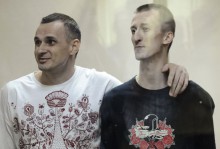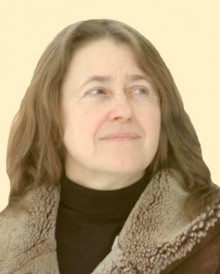The Kremlin Ukrainian prisoner, filmmaker Oleh Sentsov, spent about two weeks at the SIZO pre-trial detention facility of Chelyabinsk not so long ago. He had a visitor, Tatiana Shchur, member of the Russian Federation’s Public Monitoring Commission in Chelyabinsk oblast and of the Independent Observers Team led by her husband Nikolai Shchur. Mrs. Shchur immediately shared her impressions on Facebook: “Oleh says not to worry about him. He had a dream last night about a new script. Apparently, the man has more on his mind than prison routine, however depressing. Once an artist, always an artist. Creative personalities remain true to their calling. It is our duty to wait for their release and campaign for their freedom.” Several days later she informed that Sentsov had been sent from the SIZO on his way to the “place of incarceration,” and that she and her colleagues were planning to visit another Kremlin Ukrainian prisoner, Oleksandr Kolchenko, in a week’s time.
Tatiana Shchur has been a member of the Public Monitoring Group for almost six years. Despite pressure from authorities, she has accomplished a lot. In fact, helping political prisoners is just one aspect of her and Nikolai Shchur’s activities. Tatiana has been at the head of the Women of Eurasia Association since 2004 while actively defending the rights of children, especially orphans. In 2005, The Time named the couple among the European Heroes as prominent human rights activists. Ukrainians must know about such personalities because they are the reason why – by analogy with Prague in 1968 – we won’t start hating the Russian people.
SENTSOV CAN BE SOMEWHERE ON TRANS-SIBERIAN RAILWAY
How did you arrange for a visit to Oleh Sentsov at the SIZO? It was easier said than done, wasn’t it?
“We learned from the Internet that Oleksandr Kolchenko would serve his term in Chelyabinsk. We kept browsing and found out that he would arrive at the SIZO on February 23. This detention facility serves as a transit prison from where the convicts are sent to their respective places of incarceration. We then contacted the Federal Penitentiary Service and learned that Kolchenko had been sent to Corrective Labor Colony No.6 in Chelyabinsk oblast, also that another convict, Oleh Sentsov, was at the SIZO awaiting transportation, so we hurried there to arrange for a visit.
“As a member of the Public Monitoring Commission, I’m legally entitled to visit any penitentiary, at any time. I visited the SIZO with my husband Nikolai Shchur (he is also a member of the PMC). We were let into Oleh Sentsov’s cell. After that, with the convict’s consent, we were shown into what they call the investigators’ room. Under the law, PMC members have the right to interview convicts in private, with the security cameras on but sound off. In our case the cameras were off, too. We knew that he had been transported there a week before our visit.”
How long have you been monitoring the Sentsov-Kolchenko case?
“From day one of the trial. We’re interested in all people who resist injustice and Oleh Sentsov is especially interesting for the Russian and world creative intelligentsia. The absurd charges and rigged trial are too obvious.”
There have been media reports about Sentsov being transported to a forced labor camp in Yakutia, followed by reports about his being sent God knows where. Do you know the exact place?
“Yurii Blokhin, PMC member in Rostov oblast, has confirmed Yakutia. They were informed as Sentsov was en route. Sentsov is being transported by rail, with stops. Such stops can last a month. No one knows where such stops take place. For all we know, he can be somewhere on the Trans-Siberian Railway. Each city along the railway has a SIZO, a transit prison. We can only wait for information from unofficial sources and local human rights activists. Also, they could have transported him in a different direction. The authorities were in a hurry to get Sentsov out of Chelyabinsk, most likely because of the media coverage of the Nadia Savchenko trial. Another probable reason is they wanted to prevent us from informing him about what was going on.”
SENTSOV BELIEVES IN FRIENDS AND HAPPIER FUTURE
Recently the Syktyvkar City Court ruled that the Federal Penitentiary Service of the Russian Federation find a place of incarceration for the third Ukrainian Kremlin prisoner, Hennadii Afanasiev, somewhere closer to Simferopol, his home town. Oleh Sentsov is in a situation similar to that of Afanasiev. Is there any way he can have the place of incarceration changed?
“His relatives and the convict must file applications with the FPS in Moscow, along with certificates concerning his physical condition, age, children, ailing parents. The FPS is the only authority to change the location of incarceration. In fact, sending a convict to serve his term so far away from home is against the Russian law, but he is dangerous because he is well known and independent. Oleh isn’t complaining about the conditions of his incarceration. He’s complaining about the place. He says he is an unpretentious man, he needs no privileges and feels ill at ease when shown any; that he was even glad to find himself in a prison cell packed with inmates, considering that before that he had been practically in solitary. He is interested in communicating with fellow inmates. He sees scripts in his dreams. Oleh is a very attractive, ironical, witty, and creative individual. He is also steadfast because he knows his cause is right. He understands everything about Russia, Ukraine, and politics. He firmly believes in his friends and a happier future.”
PRACTICALLY NO VOICES OF SUPPORT FROM UKRAINE
Is the Kremlin prisoners topic popular with the general public in Russia? Much is being said and written about the Savchenko case, with the trial nearing its finale. Many public statements have been made. Are the Russian media paying attention to the other Ukrainian political prisoners? How does the Russian in the street feel about all this?
“There are specific communications in daily life and on the Internet. There are human rights activists, democratic circles, and social network communities, all of them like-minded individuals. They are outraged and alarmed, but I don’t know about the Russian in the street. I doubt that most Russians know about Savchenko and the other political prisoners, but that’s my personal opinion.”
“Let My People Go” say there are 21 Kremlin prisoners in Russia and Crimea. Is there a way to help them regain their freedom?
“The authorities should be pressured from both within and without. Russian activists are protesting, but it takes an active economic and political pressure from Europe, the United States, and certainly from the Ukrainian public and government. Your government should be prepared to claw at someone’s throat to help the prisoners. Somehow, nothing seems to be happening over at your end.
“One other thing. Back in 1968, seven individuals marched out on Red Square to protest against the deployment of Russian troops in Czechoslovakia. People in that country said they had at least seven reasons for which they would never hate Russia, even with Russian tanks clanging down Prague streets. Today we hear practically no Ukrainian voices of support for our political prisoners who are receiving terms for supporting Ukraine and the Kremlin Ukrainian prisoners.”
MOST IMPORTANT: MASS TORTURE STOPPED
As a member of the Public Monitoring Commission, you must have been exposed to pressure from authorities. How can one improve the convict’s status under such circumstances?
“My husband and I have been PMC members since 2010. This is our second tour. We’re constantly exposed to pressure from authorities. As human rights activists, besides our PMC status, we and our colleagues keep receiving threats and warnings. Quite recently three organizations headed by my husband and me were branded as ‘foreign agents.’
“Amazingly, we have accomplished a good deal over the years, stopping endless ShIZO [Russ. abbrev., penal isolator cells in prison] incarcerations among other things. At an early stage of our PMC activities we would receive numerous complaints about inmates being held in corrective labor colony ShIZO cells over a year at a time. Today we know that the ShIZO terms are kept strictly in accordance with the law. Not so long ago, a man who had just finished serving his term visited us and thanked us for locating him in the ShIZO of Corrective Labor Colony No.2 in 2011 when he thought he would never be let out of the isolator cell.
“Police holding tanks have been upgraded. The most odious ones have been closed. We have collected and published information concerning the so-called rubber SIZO cells and then had them dismantled. A rubber cell is like a padded cell, except that its walls are covered with hard black rubber. There are no windows, vents, no toilet. These rubber cells were meant for ‘misbehaving’ inmates. Now we regularly check such holding facilities to make sure no rubber cells have started being practiced.
“Of course, there are cases of prison guard brutality, but we are quickly notified. If the Federal Penitentiary Service fails to timely respond to our complaints, the outcome is often manifestly tragic, as was the case with a Chechen inmate of Corrective Labor Colony No.2 in Chelyabinsk. This case is still being investigated, several colony officials are under arrest on charges of suspected homicide.
“Most importantly, mass torture and extortion in prison have stopped. Back in 2012, this caused the well-known peaceful revolt in Corrective Labor Colony No.6 (Chelyabinsk oblast). By the way, Oleksandr Kolchenko is serving his term there and we’ll visit him.”








